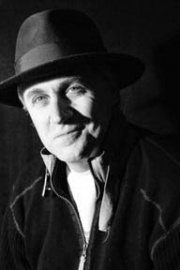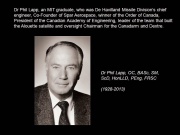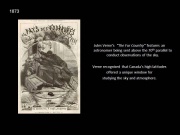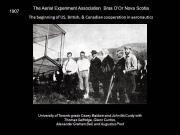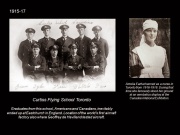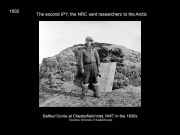100 Years of Aerospace History in Canada: From McCurdy to Hadfield by Robert Godwin
From The Space Library
Verne, The Fur Country, G.Y. Kaufman, Baldwin, McCurdy & Balfour Currie
This paper, first presented at the 65th International Astronautical Congress, Toronto, Ontario from September 29th - October 3rd, 2014, is a brief synopsis of the history of astronautics in Canada. The author wishes to thank the late Dr Phil Lapp and his wife Colleen Lapp for their permission to reveal some of Dr Lapp's memoirs. Dr Lapp was a founder of the the Canadian Aeronautics and Space Institute (CASI) and of SPAR Aerospace.
It is generally accepted that the world's preeminent pioneers in astronautics, Goddard, Oberth, Tsiolkovsky and Esnault-Pelterie were all nudged along their historic course by the writings of Jules Verne, and most specifically his serial From the Earth to the Moon. Verne's novel about mankind's first space launch holds a special place in the history of the space programs of Europe, Russia and the United States, all of which within a hundred years had developed space launch capabilities. Since Canada has never had its own orbital launch capability the student of Canadian astronautics needs to look more closely at the Canadian contributions to its forebears, aeronautics and astrophysics, and also, to a lesser degree, Canada's relationship with early science fiction.
Robert Goddard, the eminent American rocket pioneer often reported in his diary his affection for science fiction. As well as reading Verne he had also been inspired by H.G. Wells' War of the Worlds and its unauthorized sequel Edison's Conquest of Mars.
The sequel, written by American astronomer Garrett Putnam Serviss, appeared in a multitude of Hearst newspapers in early 1898, but in its Boston Post iteration, the one which Goddard read, it featured many illustrations of spacecraft drawn by Canadian Pacific railway artist G.Y. Kaufman, making Kaufman one of the first in history to portray a fleet of spaceships. Goddard kept the original newspaper serial and referred to it as late as 1929.
As well as From the Earth to the Moon Jules Verne wrote a novel set in the high Canadian arctic called The Fur Country in which a scientist/astronomer travels to the North West Territories, above the 70th parallel, to study aurora and witness an important eclipse.
It seems fitting that as early as 1873 Verne recognized that Canada's high latitudes offered a unique window for studying the sky and atmosphere. Indeed, geography and climate are what have propelled Canada's space program since its inception.
Canada became an early contributor to aeronautics when the Scottish born/American citizen/Canadian resident, Alexander Graham Bell put his substantial personal resources into pioneering aviation. Shortly after the Wright Brothers' famous first flight, two Canadians, Casey Baldwin and John McCurdy, teamed up in 1907 with Bell and Glenn Curtiss to form Canada's first cross-border alliance in aviation, The Aerial Experiment Association.[i]
These pioneers shuttled back and forth between Hammondsport New York, and Bras d'Or Lake in Nova Scotia testing their designs before McCurdy became the first to fly an aircraft in Canada on February 23rd 1909.
McCurdy and Baldwin were pioneers in a long line of University of Toronto students who would conduct world-class research into aerodynamics. A little over a year after that first flight in Canada, Haden Herbert Bales of Ashcroft British Columbia patented the first design for what would become known as Jet Assisted Take Off (JATO). Bales proposed installing a battery of solid fuel rockets behind the centre of gravity in an aircraft as a method of last resort if the main engine failed.[ii]
In 1915 Glenn Curtiss continued his cross-border work when he set up a flying school at Long Branch, in the western suburbs of Toronto. This would be Canada's first aerodrome where the Royal Flying Corps would train pilots to fly for the allies in World War I; many Americans also trained there in the summer months.
A little-known footnote to this story is that Amelia Earhart lived in Toronto where she trained as a nurse. She visited Long Branch in 1917 and later admitted that it was because of her time watching pilots at the Canadian National Exhibition in Toronto that she became interested in flying.[iii]
Most of the pilots from Long Branch ended up operating from bases such as Eastchurch in England, where they were given a glimpse of the world's first aircraft machine shops, built under license from the Wright Brothers by the Short Brothers. They were exposed to enterprising aviation stalwarts like Charles Rolls and Frederick Royce and also Geoffrey DeHavilland who tested his early aircraft at Eastchurch.
In 1927 DeHavilland Aircraft announced that they would build a manufacturing plant in Toronto.[iv] Thus began a triangle of aerospace correspondence between Canada, the USA and England that continued for the rest of the 20th century.
Canada's first practical study of space began in 1882, only nine years after Jules Verne's book The Fur Country, and during the first International Polar Year (IPY). Researchers from England, the United States and Germany traveled to Baffin Island, Ellesmere Island and the shores of the Great Slave Lake in the North West Territories (NWT) to study our planet and its weather.[v]
These early atmospheric scientists represented the first stirrings of the astrophysics branch of Canada's space history. In 1932 a second IPY would spur a team led by Balfour Currie to set up a research station at Chesterfield Inlet (NU) to study the aurora.[vi]
The research begun by Currie and others would set the course for Canada's principal role in space science which continues to this day; the study of space weather and its effects on climate and communications.
The 75th anniversary of that first IPY would inspire the International Geophysical Year which of course led directly to the global Space Race competition and the launch of Sputnik 1.
While Currie and his team were in the north, conducting high altitude atmospheric studies, at least one Canadian, had moved south of the border to try his hand at building rockets...
Vignettes of Canadian Aerospace History by Robert Godwin (2014);
Footnotes
[i] Canada's Flying Heritage, Frank H. Ellis, U of T Press, 1954
[ii] Pyrotechnical Auxiliary Propelling Mechanism For Aerostructures U.S. Patent #1,003,411
[iv] Globe and Mail Nov 29 1927
[v] http://www.arctic.noaa.gov/aro/ipy-1/index.htm
[vi] Canada's 50 years in Space, Gordon Shepherd and Agnes Kruchio, Apogee Books, 2008
